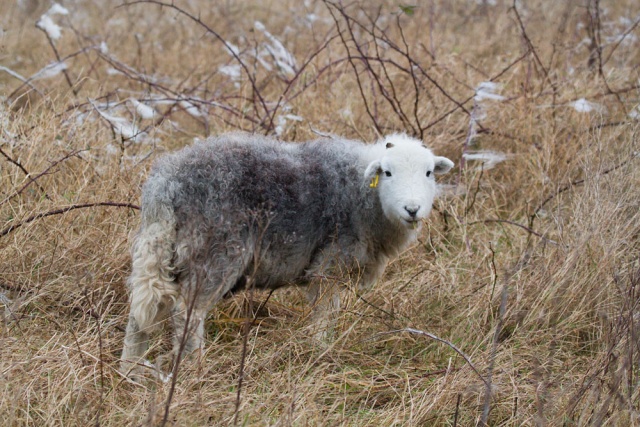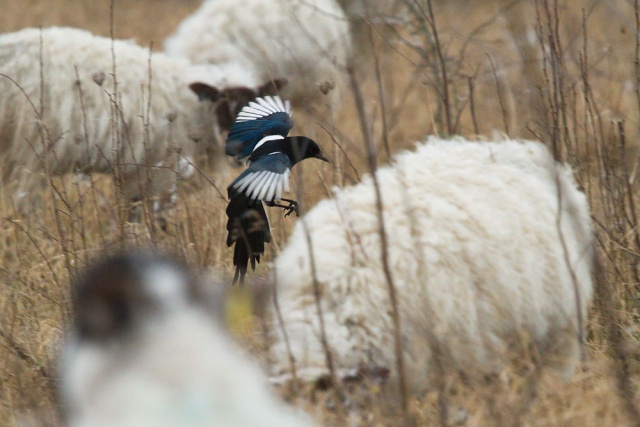Or possibly grey, which perfectly describes the clouds this morning. It also suits this grey sheep which was grazing (appropriately) at Sheepcote Valley just after dawn.
This next shot is low quality due to the terrible light and high ISO, but it's the reason for the blog title. It's a crow, but a leucistic one showing clear white feathers evenly spaced along the length of both wings. Leucism is fairly common among crows (and jackdaws) and I have come across more extravagant examples, but this one shows the condition well enough.
Another black and white corvid to close, but this time it's meant to be that way. A magpie, of course, coming in to land among the sheep. 
Camera note: all shots taken with the Canon 7D and EF 100-400mm f/4.5-5.6L USM IS lens.
derWandersmann
9 Jan 2013I've never seen crows exhibiting leucism, Words. It must be rare-to-nonexistent over here. I'd heard of it, of course, but this was something special.
I get a chuckle out of the tufts of wool caught in the weeds … it reminds me of the beginnings of the CSIRO protein-injection method of wool removal, before someone thought of the nets.
serola
9 Jan 2013Indeed surprising to see that crows can have also white in their wings.
SittingFox
9 Jan 2013Interesting shot of the crow.
Originally posted by derWandersmann:
I've never seen leucism in North American corvids either, but I suppose it does occur.
chthoniid
9 Jan 2013It doesn't look like a happy sheep 🙂
gdare
10 Jan 2013I like that one with magpie and sheep :up:
derWandersmann
10 Jan 2013Sheep seem to have a naturally lugubrious expression.
The magpie is pretty that way, isn't he, Dare?
gdare
11 Jan 2013Very :yes:
Words
13 Jan 2013Sami, as I've mentioned it's not all that rare. Somewhere I have a much better example but I can't find it at the moment. Yes I can: http://my.opera.com/Words/blog/2009/07/17/white-crow-and-lots-of-foxes 😉
Words
13 Jan 2013Adele, I've always presumed it was genetic but I do wonder about environmental triggers, but I guess both could make it common among localized populations.
Words
13 Jan 2013Chtoniid, I'm not sure if it's possible for sheep to smile, but it has an easy life. It's sole work is to eat the scrub 🙂
Words
13 Jan 2013Darko, thanks!
Words
13 Jan 2013dW, leucism seems quite common over here among corvids (crows and jackdaws in particular). I don't know whether it's localized to certain habitats.
Interesting comment about the wool. I had to do a quick search. I'd not come across that method of wool harvesting before.
derWandersmann
14 Jan 2013Originally posted by Words:
When they first thought of it, they hadn't realised the necessity of the nets, and they came out to find most of the "crop" lodged on bushes and brambles … this was in NZ, I believe, but it was a long time ago, and CRS occasionally manifests itself.
SittingFox
14 Jan 2013I suppose there might be odd incidents of environmental causes, but in mammals at least it's genetic, and typically shows up in populations with limited out-breeding (e.g. white black bears are more common on isolated islands). What that means in the context of a bird as common as the crow, is hard to say.
serola
14 Jan 2013Thanks Words for the link :up:
Words
14 Jan 2013Adele, I'm sure you're right. It's a fairly common feature here among crows and jackdaws which would point to a stable population I imagine.
Words
14 Jan 2013dW, that's fascinating. I take it they still shear in the traditional way most of the time. It's probably almost as quick.